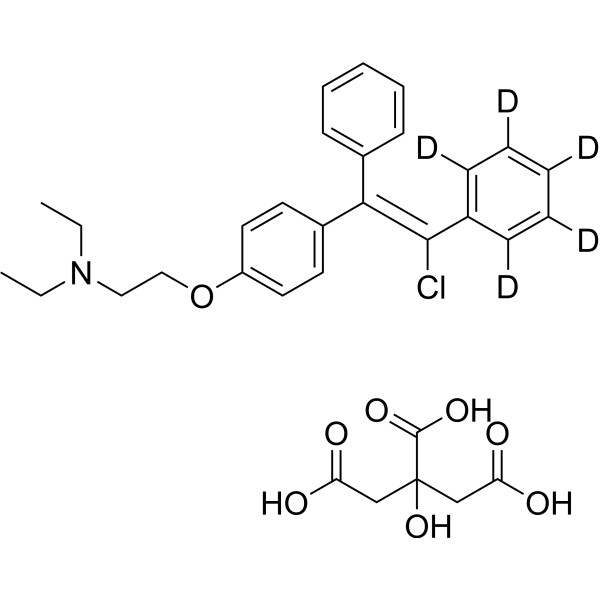Zuclomiphene-d5 citrate
Modify Date: 2024-01-30 17:58:15

Zuclomiphene-d5 citrate structure
|
Common Name | Zuclomiphene-d5 citrate | ||
|---|---|---|---|---|
| CAS Number | 1795132-80-7 | Molecular Weight | 603.11 | |
| Density | N/A | Boiling Point | N/A | |
| Molecular Formula | C32H31D5ClNO8 | Melting Point | N/A | |
| MSDS | N/A | Flash Point | N/A | |
Use of Zuclomiphene-d5 citrateZuclomiphene-d5 (citrate) is the deuterium labeled Zuclomiphene citrate[1]. Zuclomiphene citrate is a cis isomer of Clomiphene citrate. Zuclomiphene citrate has an antiestrogenic effect and can inhibit the secretion of luteinizing hormone (LH) more than the trans isomer. Zuclomiphene citrate is also an orally active hypocholesterolemic agent[2][3][4][5]. |
| Name | Zuclomiphene-d5 citrate |
|---|
| Description | Zuclomiphene-d5 (citrate) is the deuterium labeled Zuclomiphene citrate[1]. Zuclomiphene citrate is a cis isomer of Clomiphene citrate. Zuclomiphene citrate has an antiestrogenic effect and can inhibit the secretion of luteinizing hormone (LH) more than the trans isomer. Zuclomiphene citrate is also an orally active hypocholesterolemic agent[2][3][4][5]. |
|---|---|
| Related Catalog | |
| In Vitro | Stable heavy isotopes of hydrogen, carbon, and other elements have been incorporated into drug molecules, largely as tracers for quantitation during the drug development process. Deuteration has gained attention because of its potential to affect the pharmacokinetic and metabolic profiles of drugs[1]. |
| References |
| Molecular Formula | C32H31D5ClNO8 |
|---|---|
| Molecular Weight | 603.11 |